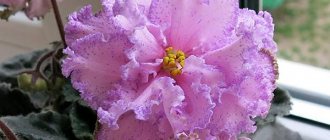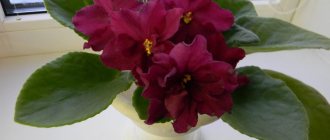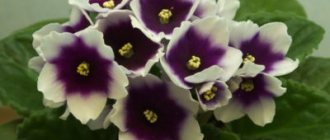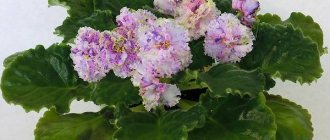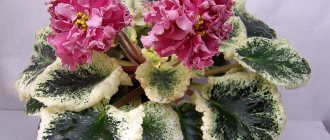Violet Emergency (Accident) delights its owners with bright semi-double or simple pansies in a bright red shade with a snow-white edging.
The variety belongs to large standards . The leaves are wavy, spoon-shaped, and have a red underside.
The rosette is flat ; in insufficient light, the leaves rise upward. When exposed to excessive light, the lower leaves become yellow.
Violet Emergency (K. Stork)
Emergency blooms with simple or double flowers . The flower is a blood-red pansy with a bright white border along the edge of the petal.
Saturation and brightness do not disappear even during the summer heat , which adds to the attractiveness of this variety.
Photo of Violet Emergence.
Despite the fact that the Emergency violet does not form a bouquet , it is in demand among collectors. Unlike many other varieties, Emergency blooms for a very long time, does not fade over time , and also maintains a white border regardless of the circumstances.
Each peduncle forms at least five buds . They are long and drooping. This is the only significant drawback of this variety. The flowering is long and lush, but collecting all the flowers in one heap is very difficult.
There is no variegation or imprints. The sheets are smooth, with a rich red underside.
When growing this variety, problems may arise with the formation of a rosette. She may resemble a spider.
The cuttings are very long and the leaves are crooked. This is a sign of going into sports. Such children are rejected at an early age.
Also, one of the signs of a genetic mutation is an excessive number of double flowers and the absence of simple pansies.
Violet YAN-Glass (N. Puminova)
Beautiful violet YAN-Glass.
Creator of the variety
An expressive violet with airy flowers, shaped like double rosehip flowers, and a neat silhouette of a variegated rosette was born in the process of selection experiments with varieties of Saintpaulia by Moscow flower grower Natalya Aleksandrovna Puminova .
The variety stands out among the global diversity of Uzambara violet lines from other domestic breeders with the abbreviation “YAN” in the name. It was Natalya Alexandrovna who introduced this original way of distinguishing the Saintpaulia varieties of each master into Russian violet growing.
For about a quarter of a century, the discerning breeder has been engaged in :
- Popularization of violets;
- And creating your own line.
The authorship of this variety belongs to Natalya Puminova.
registers her varieties , since she is very scrupulous about the varietal characteristics of violets, their fixation and verification.
Specimens of the variety:
- Participating in various exhibitions since 2009;
- They are constantly favored by specialists;
- Take prizes;
- They also enjoy the sincere love of flower growers.
Taxonomy
Based on the official hierarchical rules for systematizing taxa of botanical units, the violet variety is classified as:
- Arousing sincere admiration for the perfection of the multifaceted palette of images;
- The Saintpaulia genus, unlimited in its varietal diversity;
- Included in the Gesneriev family.
The variety belongs to the Gesneriev family.
Specimens of the described violet include:
- In the section of standard parameters for the volumetric dimensions of the bush;
- They also belong to the variegated varieties of Saintpaulias according to the way their leaf blades are colored.
Photo and description of the variety
Adult specimens of varietal Saintpaulia, growing in home collections with constant provision of a microclimate that is comfortable for them, are characterized by:
- Chic volumetric - spatial symmetry of variegated rosettes;
- And a dense degree of filling with leaves.
Over time, bushes acquire:
- Significant compactness;
- And a clear, aligned configuration.
According to the author's description, the violet should have standard parameters, but many gardeners point to the presence of rather enlarged rosette dimensions , which are close to the upper limits of the size characteristics.
The violet of this variety, when going through the phase of active growth and determining the final format of the rosette, does not cause significant trouble for gardeners , since its growth is characterized by great independence.
Saintpaulia carefully and evenly distributes the leaf plates filling the rosette in a thoughtful order according to the number of tiers required according to the characteristics of the variety, necessary for the decorative effect of the plant.
After the end of the growth stage, the violet looks like an elegant bush with the splendor of the mosaic architectural graphics of alternating leaves distinguishing it from other specimens.
IMPORTANT! This technique in constructing a rosette makes it possible for all its sections to be almost equally illuminated by the rays of the luminary, receiving an optimal portion of solar energy for development.
The presented variety has few disadvantages.
The only drawback of the variety is the slightly elongated petioles of the leaf blades of young violets, which gives the specimens a somewhat loose outline. Imperceptibly, this feature disappears on its own, without leaving even a hint of the unaesthetic structure of the bush.
Violet leaves have:
- Medium dimensions;
- Oval – elongated shape with a smoothly tapering tip;
- Smooth surface texture;
- And a barely noticeable venation pattern, distinguished by the light green shade of the color of the thin veins.
The edges of the leaves are decorated with small, rounded teeth with clearly cut graphics .
INTERESTING! The format of the contours of the leaf blades has a specific feature - almost all the leaves bend upward, creating the outlines of small boats. In addition, the growing plates in the form of half-opened tubes rise strictly vertically, but then smoothly assume a horizontal position in their proper places in the rosette. This gives the violet a decorative mystique.
Violet leaves have an unusual color.
The first phases of rosette growth are marked by the coloring of the leaf blades with a relatively even shade of green with a slight hint of a variegated leaf structure. But along with the maturity of the bush, the bordering variegation of white tonality, which is obligatory for the variety, begins to intensify its brightness.
The underside of the leaves has a light green palette with a whitish coating, on which reddish-brown veins clearly appear.
Flowering in the variety is observed:
- Extremely lush;
- And it lasts a long time.
The moment of first budding occurs at the classic time, although the buds may not open for a long time . According to the breeder's description, the flowers may begin to open slowly, taking about five to seven days.
Saintpaulia begins to bloom with single flowers or small caps, which, as the violet matures, gradually gain maximum strength and splendor.
Violet corollas are different:
- Terry degree of filling with petals;
- And medium in size.
The petals have a wavy structure with a dense, finely jagged fringe, which is responsible for a significant increase in the volume of the corollas and increased decorativeness of the caps.
NOTABLE! The name of the variety directly indicates the presence of a goblet-shaped violet corolla. But such a constitution of flowers is observed only when the buds are not fully opened, disappearing after the final dissolution. To preserve the corolla glass, flower growers recommend underfeeding the plant during the flowering period - then it will not have enough strength to open the flower. The cool microclimate of the room can also contribute to this.
Saintpaulia flowers are colored pink.
The color palette of the corollas is pastel shades of pink . The outer side of the lower petals has a light touch of greenish tint with a soft brownish edging along the edge.
Sports
Violet is not seen in the creation of sports varieties.
Caring for a plant at home
The variety is capricious and its maintenance requires experience and skills. It cannot be said that if this plant falls into the hands of a beginner, it will die, but there is no guarantee that the violet will form a correct and beautiful rosette.
It is very important to get the lighting right . If there is too little light, the violet begins to pull the leaves up. With too much light, the lower leaves begin to age prematurely and die.
Proper watering and fertilizing
This variety does not tolerate wick watering. Does not like excessive humidity. It is best to water from below or at the root.
Saintpaulia Emergency does not like too much fertilizer.
If you overfeed her, then instead of pansies she will produce double flowers, which will not be a sign of sport.
Lighting and temperature
Violet prefers natural light. Loves diffused light, but can also feel fine when exposed to direct sunlight.
At the same time, it reacts poorly to heat. Flowers in such conditions do not float and do not fade. The color becomes more saturated over time and the petals acquire a crimson hue.
In order to form a beautiful rosette, you need to experiment with lighting and, if necessary, tear off the lower leaves if they begin to pull out cuttings.
Attention! Good lighting must be provided from early childhood.
Air humidity
Emergency violet is unpretentious, but does not tolerate excessive humidity . It is enough if this figure fluctuates between 50-60%.
Transplantation rules, selection of soil mixture
Violet can be replanted in autumn or spring. It is best to do this in February. After transplantation, the plant will have time to take root and bloom in a timely manner.
In summer or early winter, it is better not to replant violets ; they do not take root well. This can only be done in an emergency, when the plant is sick or has been attacked by parasites.
Soil composition:
- 2 parts leaf soil;
- 1 part of coniferous land;
- 1 part of turf land;
- 1 part peat;
- 1 part crushed sphagnum (this is moss);
- 0.5 parts sand (preferably river);
- a small amount of charcoal.
The soil mixture should allow air to pass through well and not retain moisture.
Pruning and hygiene
Saintpaulia Emergence requires constant care. In order for the rosette to be smooth and beautiful, it is necessary to control the size of the rosette from a very early age.
If it turns out that the petioles of the lower leaves have become too long, they are removed.
Advice! It is also worth removing faded buds and flower stalks.
Reproduction methods
Most often, this violet variety is propagated by leaf cuttings. It takes root readily and produces a large number of children. Sports are formed quite rarely. They can only be noticed after flowering. Specimens with crooked leaves are also rejected. This is considered a genetic mutation.
If side shoots (stepchildren) , then they can also be rooted and a new plant can be obtained.
Rules for transplantation and variety rejuvenation
When transplanting a young plant, it is transferred to a larger container.
An older plant requires more attention. Part of the root system is slightly removed using disinfected scissors, and then the cuts are sprinkled with crushed coal.
You can remove a third or even half of the roots. Over time, the violet will grow young roots and the plant will become healthier.
If the rosette is old and has a stem that is too high, which spoils its appearance, then it can be rejuvenated:
- The plant should be cut at soil level;
- Carefully scrape the top part of the bark from the surface of the stem, sprinkle with crushed coal and place in water;
- After 15-20 days, the rosette should form roots;
- After this, the plant is transplanted into a new pot.
Autumn violet bloom: Emergency, Your Majesty, Anastasia…
Good day to all, dear violet lovers! I would like to introduce you to several varieties in my collection that have been blooming in recent days. I do this with some trepidation, since I photographed my violets for the first time, and all (even the smallest) peaks in photography, I hope, are still ahead of me. I would like to know your opinion about the presented varieties; I am sure that many have them in their collections. Or maybe someone was disappointed in them and gave them “in good hands.” Share your stories, I find it very interesting.
Emergency (K. Stork):
This variety has been living in my house for a very long time. Rosettes were born, grew, grew old, but they were always there. I love it for the rich, deep velvety color of tart red wine, for the brightness of the white border and the beautiful transition of one into another. I haven’t noticed that this violet’s flowers become smaller or unattractive; if it doesn’t like the conditions, it simply doesn’t bloom. All last summer she was angry and folded leaves into a boat, indignant at the unbearable heat. And only now it has revealed itself.
I’m not very good at forming a beautiful rosette on this variety: the leaves desperately stretch upward. But I'm still a fan of hers.
Your Majesty (Makuni):
In my opinion, this is a masterpiece of domestic violet selection, a gift from a true Master. In G. G. Komkov’s poetic notebook dedicated to violets, a photograph of this variety is accompanied by poems by B. Okudzhava:
Everything here is curtained with darkness and silence is like at the bottom. Your Majesty, Woman, is it really possible to come to me?.. The electricity here is dim, water is oozing from the roof, Woman, Your Majesty, how did you decide to come here? Who are you? Where are you from? Ah, I'm a funny person. You just confused the door, the Street, the city and the century.
This is the only variety of violets to which the author's song is directly dedicated (I found Alla Gozun's album on the Internet). What is amazing to me is the ability of this flower, once opened, to gain strength every day. The cute pompom gradually increases in size, thickens and turns into a delicate, sparkling ball.
Anastasia (Sorano):
In this photo the flower has its head thrown back, in fact the lighter petals are located on top. Flowers of this variety are tenderness itself. I don’t know whose name inspired the creator of the variety to name it, but everything is obvious to me. Nastya is the name of the girl my son dances with.
This photo was taken two years ago, when they first became a couple, but the color of the dress is almost guessed.
Galactic Dancing (Sorano):
I saw the translation of the title in two versions: “Dancing Galaxy” or “Galactic Dances”, I like the first one better. I can’t add anything, because I just love this variety for the peas that are dear to my heart.
And in the end I want to introduce you to my growing harvest. Lemon is directly related to violets, because it grows next to them on the same windowsill and steadfastly endured all the hardships of the summer season together with them. He has lost half of his leaves, but he also seems to be coming back to life.
I really hope that the violets will continue to bloom. Ahead are the debuts of varieties that appeared to me thanks to the catalogs on our website. Will wait.
Features of flowering, growth and reproduction
The petiole produces a sufficient number of children, which quickly take root and develop. , 8-9 months can pass
Most often, the variety is propagated by the leaf method, but if the rosette has produced a lateral shoot, it can be successfully rooted. Sports rarely give , they can be noticed immediately by the uneven curly leaves.
Gives good and abundant flowering even in the heat. Doesn't fade or float. Doesn't like too high a temperature, but holds the rich color well.
Prefers good natural light. It is best to place it on the east or west side. Can tolerate direct sunlight in the morning or evening.
The peduncles are long, lie haphazardly and deviate in different directions. It is very difficult to achieve lush cap blooms from this variety.
It blooms for a long time and a lot, but you should control the length of the peduncle using lighting. If you feed a violet, double flowers will appear instead of pansies.
Reviews
Raisa, Moscow. “I grow all the children that the cutting produces. As they grow, I select specimens with the most compact sockets. I delete all the others. The phenomenon of spider legs is quite common among violets. It was standing on the windowsill, but now I put it under the lamp and double flowers appeared.”
Karina, Mariupol. “My violet’s rosette has reached 30 cm. It’s the only one among all varieties. I decided to break it off a little to check the size. If it is too light, the leaves immediately begin to lift up. I don’t use a pot larger than seven, otherwise she will grow up to be a real elephant.”


